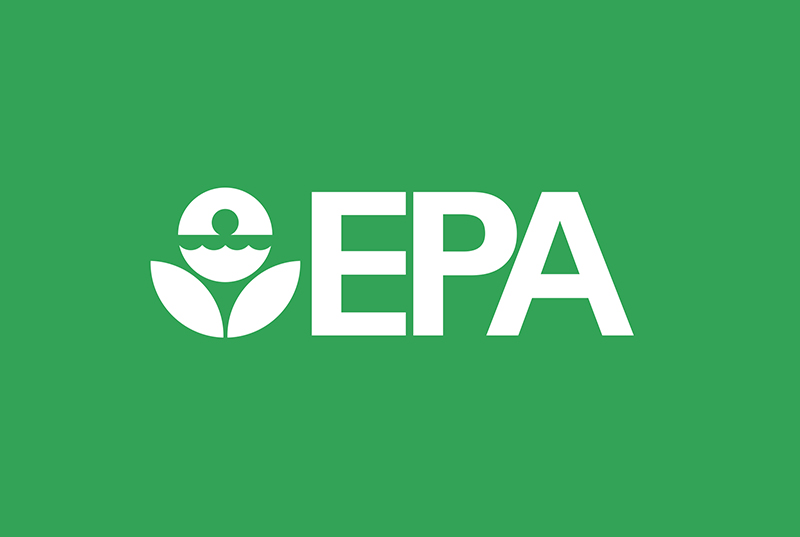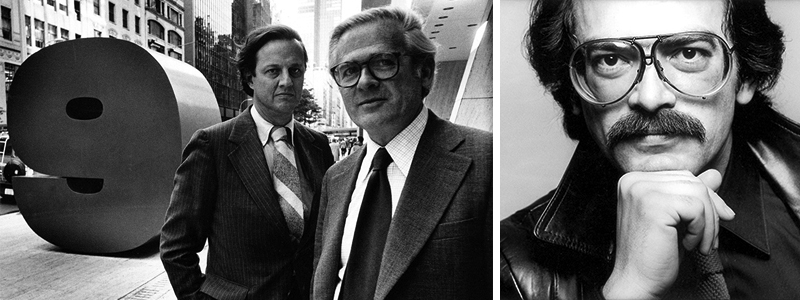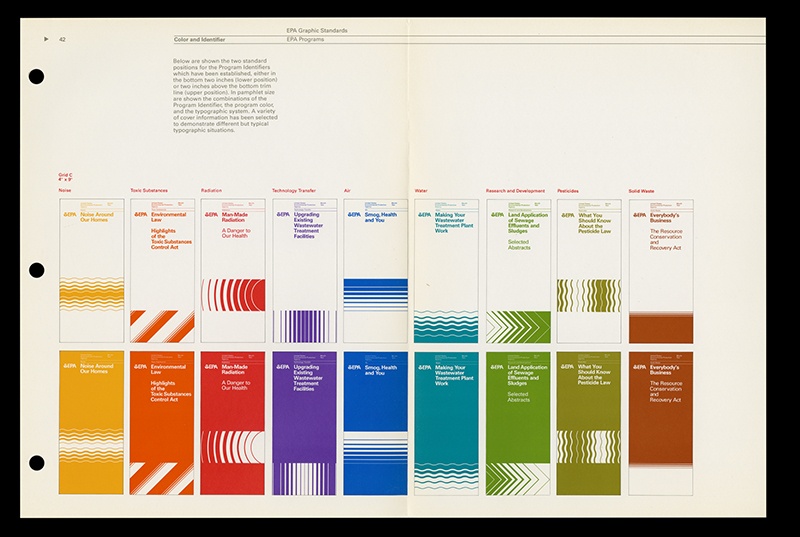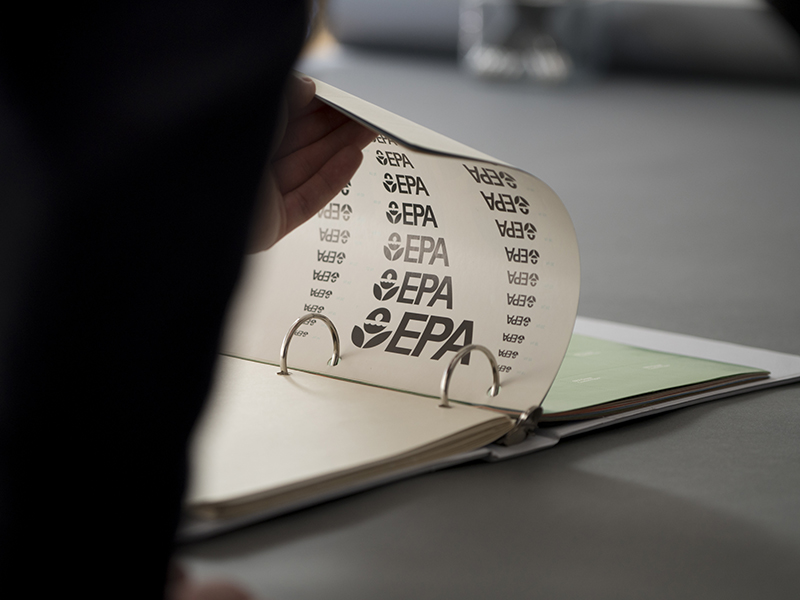
EPA logo, Chermayeff & Geismar & Haviv, 1977
The 1960’s and 70’s in the U.S. were ripe with a national environmental awakening, leading to reforms and designs that have endured with strong nonpartisan support. Only recently, has this progress been is at risk of being discarded, causing global audiences to take a stand for the environment by sharing their pride in its history and hopes for its future. Today, AIGA | the professional association for design, Chermayeff & Geismar & Haviv, and publisher Standards Manual joined this new awakening when they announced that they will release a reissue of the 1977 U.S. Environmental Protection Agency (EPA) Graphics Standards System. Could this reissue, an artifact of the past, become a symbol of U.S. designers in support of the environment?
The history.
In 1962, Rachel Carson’s Silent Spring was published, taking a critical look at pollution in the United States and jump-starting the environmental movement. Then in 1969, the Cuyahoga River in Ohio—after decades of being badly polluted with debris, oils, sludge, industrial wastes, and sewage—caught on fire again, finally bringing national attention to water pollution issues and initiating water pollution control activities. The largest Cuyahoga River fire (yes, it happened many times) was more than a decade earlier and caused over a million dollars in documented damage and lasting environmental impacts.
As a direct result of this increased national public conscious, in 1970 republican President Richard Nixon created the United States Environmental Protection Agency (EPA) to confront environmental pollution and protect the health of the American people. That same year, more than twenty million Americans participated in one of the largest grassroots community service movements in U.S. history, the inaugural Earth Day. The United States stood together around the need to protect our environment for future generations.
“Restoring nature to its natural state is a cause beyond party and beyond factions. It has become a common cause of all the people of this country.” President Nixon in his 1970 State of the Union addressWith the creation of a new agency, came the need to communicate complex ideas to broad audiences, all the while keeping production costs down. After all, those costs were ultimately funded by American tax dollars.

Left: Ivan Chermayeff and Tom Geismar, with their sculpture for 9 West 57th Street, New York City. Right: Steff Geissbuhler, designer at C&G who worked on the EPA Graphic Standards System, circa 1975
In 1977 the EPA began working with the design firm Chermayeff & Geismar and the designer Steff Geissbuhler (now Chermayeff & Geismar & Haviv, or CGH), to help the agency more efficiently carry out its goal of “working for a cleaner, healthier environment for the American people.” Steff Geissbuhler designed the experience and the visual system for the EPA setting the tone for the agency for decades to come. The end product was the EPA Graphic Standards Manual and the brand of the EPA.

Flash forward to today.
It’s 2017 and the EPA is the same agency whose budget the current administration plans to cut by 31 percent. It’s also the same agency whose staff the administration plans to lessen by fifteen thousand employees. However, public sentiment on the need for environmental protections and scientific action seems to remain strong and may even be building once again.
Earth Day is now celebrated every year by around 1 billion people worldwide. This past weekend on Earth Day, a nonpartisan march, March for Science, brought masses of protesters to the streets in more than 600 cities around the world, showing that defunding much-needed environmental science is not something that will happen without a well-strategized fight.
In fact, the act of republishing the standards at this time is at once an act of preservation, celebration, and provocation. The humble standards manual has the opportunity to become the most accessible US-based artifact on the need for lasting, bipartisan support to protect our environment. It’s resurgence may move it beyond the status of an aging historical document and position it to create a new window for insight into the mission of the EPA as conceived by President Nixon. Is the agency itself government waste or does it protect us from our own waste? Nixon and the brand speak strongly in favor of the later sentiment, necessary protections.
Like it or not, standards manuals are indeed experiencing a renaissance. Upon the 2014 publication of Manuals 1: Design and Identity Guidelines by Unit Editions in London, the Atlantic reminded us that standards manuals typically “are ephemeral, and many were simply discarded when identities changed or businesses merged or closed.” Yet, it’s not clear that all manuals have the same opportunity to champion a cause as the EPA manual may have today.
Inside the EPA manual, I’ve seen glimpses of the frank facts we need right now. Down to the placeholder copy found on one page, which reads, “Americans have come to look back with nostalgia at the pristine state the Nation once enjoyed.” I believe this is the type of sober reminder we need to find and amplify in todays trying times.

Writing in tomorrow.
Can we go back to the 1977 awareness and ensure the protection of the EPA’s legacy and the environment it protects? If we continue to rise as masses, as we did in the 1960’s and 70’s, as we have each Earth Day, and we did on this last, more boisterous Earth Day, we stand a chance in ensuring the protection of our resources, natural treasures, and health standards.
As supporters of the environment, health, and future generations, consider taking your first step to action by contributing to the EPA Kickstarter campaign. A portion of the proceeds will be donated to the EarthJustice organization, comprised of lawyers who fight for our environment, and to the AIGA Design Archives, so that we can continue to be inspired by our design history, and use that inspiration to act.
Also consider displaying your EPA manual as a physical badge in your home or office for your unrelenting passion for the symbolism and the possibility that still exists in the brand on the chopping block.
As designers, we may be skilled at envisioning and then working towards a desired future state. We need to bring that to play for our environment and ourselves any way we can.
Get your copy here. Proceeds will help support Earthjustice and AIGA Design Archives.

